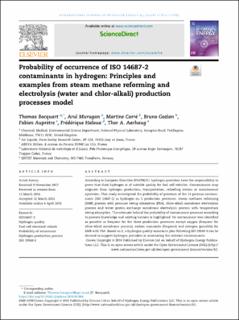| dc.contributor.author | Bacquart, Thomas | |
| dc.contributor.author | Carré, Martine | |
| dc.contributor.author | Gozlan, Bruno | |
| dc.contributor.author | Aupêtre, Fabien | |
| dc.contributor.author | Haloua, Frédérique | |
| dc.contributor.author | Aarhaug, Thor Anders | |
| dc.date.accessioned | 2020-12-11T12:50:58Z | |
| dc.date.available | 2020-12-11T12:50:58Z | |
| dc.date.created | 2018-11-21T11:04:29Z | |
| dc.date.issued | 2018 | |
| dc.identifier.citation | International journal of hydrogen energy. 2018, 43 (26), 11872-11883. | en_US |
| dc.identifier.issn | 0360-3199 | |
| dc.identifier.uri | https://hdl.handle.net/11250/2717178 | |
| dc.description.abstract | According to European Directive 2014/94/EU, hydrogen providers have the responsibility to prove that their hydrogen is of suitable quality for fuel cell vehicles. Contaminants may originate from hydrogen production, transportation, refuelling station or maintenance operation. This study investigated the probability of presence of the 13 gaseous contaminants (ISO 14687-2) in hydrogen on 3 production processes: steam methane reforming (SMR) process with pressure swing adsorption (PSA), chlor-alkali membrane electrolysis process and water proton exchange membrane electrolysis process with temperature swing adsorption. The rationale behind the probability of contaminant presence according to process knowledge and existing barriers is highlighted. No contaminant was identified as possible or frequent for the three production processes except oxygen (frequent for chlor-alkali membrane process), carbon monoxide (frequent) and nitrogen (possible) for SMR with PSA. Based on it, a hydrogen quality assurance plan following ISO 19880-8 can be devised to support hydrogen providers in monitoring the relevant contaminants. | en_US |
| dc.language.iso | eng | en_US |
| dc.publisher | Elsevier | en_US |
| dc.subject | ISO 19880-8 | en_US |
| dc.subject | Hydrogen production process | en_US |
| dc.subject | Probability of occurrence | en_US |
| dc.subject | Fuel cell electrical vehicle | en_US |
| dc.subject | Hydrogen quality | en_US |
| dc.subject | ISO14687-2 | en_US |
| dc.title | Probability of occurrence of ISO 14687-2 contaminants in hydrogen: Principles and examples from steam methane reforming and electrolysis (water and chlor-alkali) production processes model | en_US |
| dc.title.alternative | Probability of occurrence of ISO 14687-2 contaminants in hydrogen: Principles and examples from steam methane reforming and electrolysis (water and chlor-alkali) production processes model | en_US |
| dc.type | Peer reviewed | en_US |
| dc.type | Journal article | en_US |
| dc.description.version | publishedVersion | en_US |
| dc.rights.holder | Copyright © 2018 Published by Elsevier Ltd on behalf of Hydrogen Energy Publications LLC. This is an open access article under the Open Government License (OGL) (http://www.nationalarchives.gov.uk/doc/open-government-licence/version/3/). | en_US |
| dc.source.pagenumber | 11872-11883 | en_US |
| dc.source.volume | 43 | en_US |
| dc.source.journal | International journal of hydrogen energy | en_US |
| dc.source.issue | 26 | en_US |
| dc.identifier.doi | https://doi.org/10.1016/j.ijhydene.2018.03.084 | |
| dc.identifier.cristin | 1633158 | |
| cristin.unitcode | 7401,80,3,1 | |
| cristin.unitname | Nye energiløsninger | |
| cristin.ispublished | true | |
| cristin.fulltext | original | |
| cristin.qualitycode | 2 | |
